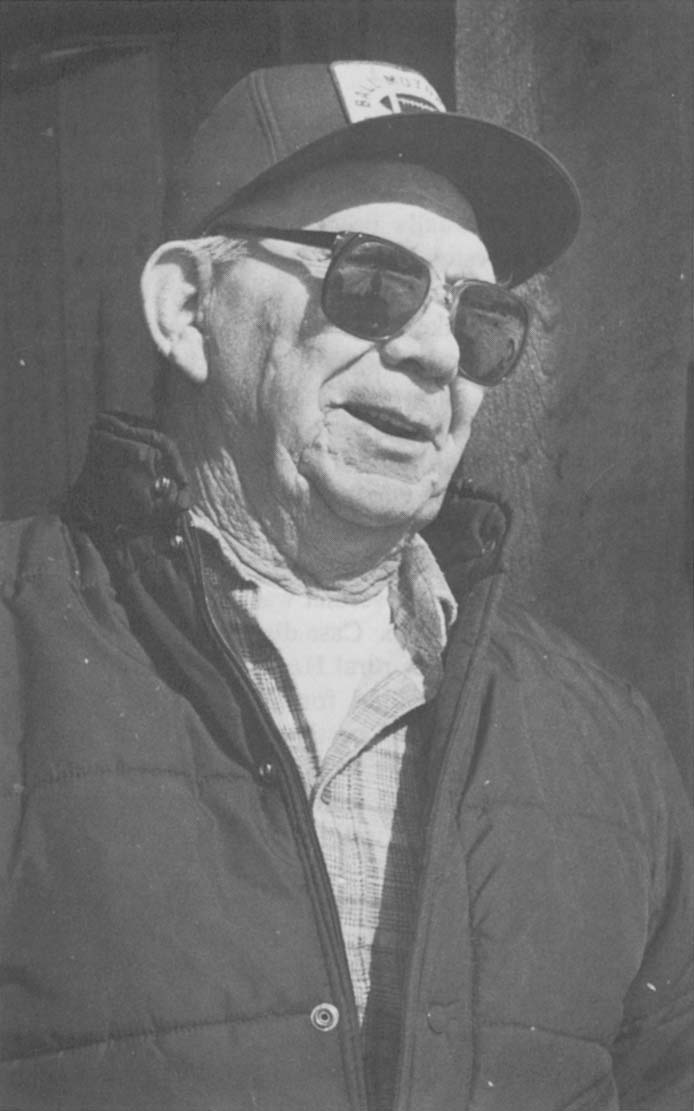Pat Miller is a housewife. Alvin Green is a farmer. Martha Laird is a housewife. Salvatore Ganci is a former construction worker and Steven Sterling is a former carpenter. They live in the rich farmland of Michigan, the desolate high desert of Nevada, the modest suburbs of East Coast cities and the back country of Appalachia. They, and thousands of others throughout America, share a common experience: Unwittingly, they have been exposed to large doses of substances known to sicken and kill.
They claim they have been injured. They want compensation from those responsible for poisoning them. But that, they have discovered, is extraordinarily difficult, and often impossible.
Pat Miller and Alvin Green have lived through the nation’s worst manmade agricultural disaster. A highly toxic fire retardant was mixed with cattle feed and distributed across much of Michigan. Mrs. Miller and Green–along with almost everyone else in the state–are contaminated with varying levels of the chemical, polybrominated biphenyl (PBB), which has been identified as a carcinogen in animals, and thus, under federal guidelines, is a suspected carcinogen in humans. They ate the meat and drank the milk from the cows on their farms, unaware of the contamination. They watched animals become sick and die. They now experience headaches, joint and muscle pains-ailments they never had prior to the PBB incident. They also have little hope of ever receiving compensation for their medical problems.


Martha Laird lived 75 miles north of the Nevada Test Site in the 1950s and recalls at least 100 clouds of radioactive fallout from nuclear weapons tests that passed over her remote desert ranch. Never once, she has testified, did anyone warn her or her family of the hazards of those radioactive clouds. “I feel that we were used more or less as guinea pigs,” she told a Congressional hearing in 1979. “The forgotten guinea pigs…To this day, they have never checked anyone in my family or anyone that I know of (for effects) from the fallout of these bombs.” Mrs. Laird’s seven-year-old son Butch died of leukemia in 1956. She believes the weapons testing program caused Butch’s cancer. She is one of 1,175 people suing the federal government for negligence. Key pieces of evidence in the trial are an abnormally high incidence of cancers among downwind residents and testimony that the government was aware of the hazards of above-ground testing. The government claims victims have not proved radiation caused the cancers. A verdict is expected later this year.
Sal Ganci began work in the Philadelphia Naval Shipyard in 1960, eventually becoming a pipe-coverer who daily handled asbestos insulation in the ship holds. He has been unable to work since 1972. Today, he has difficulty breathing and takes tranquilizers to combat what has been diagnosed as “reactive depression” caused by a fear of dying. In 1978, he sued 19 manufacturers of asbestos. In April, 1982, Sal Ganci went to court. In a series of developments Ganci still doesn’t understand, the issue before the judge was not whether he was entitled to compensation because of his asbestosis, but whether he had filed his claim in time to comply with Pennsylvania’s statute of limitations. The verdict was swift and stunning: Ganci had not filed in time. Case dismissed.
Steven Sterling lives in rural Hardeman County, TN, a mile from a landfill used for years by the Velsicol Chemical Corp’s Memphis pesticide plant to dispose of 16.5 million gallons of toxic wastes. Hazardous chemicals, apparently from the landfill, contaminated ground water in the area. Sterling said his well water began to smell “like cotton poison” and “garden spray.” When state officials sampled the water in 1978, they discovered it contained 4,800 parts per billion of carbon tetrachloride, a known cancer-causing chemical. That’s 96 times higher than the 50-parts-per-billion level designated by the federal government as unsafe for human consumption. Sterling says he has suffered liver damage and his children have been affected. He joined with his neighbors in a $2.5-billion lawsuit against Velsicol that is pending. Toxicologists testifying on behalf of the residents claim they have “quite a high risk” of developing cancer as a result of the contamination. Velsicol denies responsibility for the residents’ ailments and claims it was unaware of any problems at the landfill until 1973, when it closed the site.
These victims comprise a growing class of Americans who are caught in what has been described as a “legal-scientific quagmire.” They and their families have been exposed to the renegade byproducts of a chemical and technological age that has advanced at a firestorm pace. Left far behind are the institutions of law and equity which might protect them.
Part of the blame rests with the fact that law and science are “uneasy partners,” as one legal researcher observed. The law and science will always be in conflict. One deals in proof, the other in probability. The law does not allow uncertainty; science suspects all that is certain. Despite their inherent differences, they must be drawn together to aid the toxic-substance victim. The law is the vehicle by which the victims obtain compensation; science is the vehicle they must rely on to prove their claims. The victims of toxic substances exposure who seek restitution for their injuries have learned that the chasm between the two can be perilously broad.
In the traditional application of law, if a man is hurt in an automobile accident, he seeks damages from the person whose irresponsible actions harmed him. He has identifiable injuries which demonstrably are the result of the accident. It is a relatively clear-cut issue of cause, effect and negligence for the courts to decide. But toxic-substances compensation claims raise quite different issues, few of which have been resolved by the courts.
If a man drinks water he later learns to be contaminated with a toxic chemical and in three decades develops cancer, has he been injured just like the auto accident victim? He first must prove that the chemical he consumed was the cause of his cancer. That requirement, in and of itself, has been an insurmountable obstacle in many compensation cases, for, unlike the automobile accident, the cause-and-effect relationship in injuries of this type is far from certain. Cancer has many causes; perhaps the long-ago consumed chemical was the cause, perhaps not. Legally, speculation is not proof.
It is not only the difficulties of proving the cause that plagues victims of toxic substances. They must demonstrate that their injuries were the result of negligence, and the negligent party clearly identified. There are other legal obstacles, such as Sal Ganci’s problems with statutes of limitations. In some jurisdictions the right to sue expires before the victim is even aware of his injury. The costs of litigation deter many victims, especially because costly expert testimony is required to establish most claims.
Forgotten Guinea Pigs
In their persistent attempts to obtain compensation for themselves and for others only now experiencing the same problems, the toxic-substances victims have related their stories to judges and juries, Congressional committees, scientific panels, and anyone who might help to bring about changes in law and science necessary to aid these “forgotten guinea pigs.”
The stories they tell are of frustration and despair, of economic and physical impairments, of fears for the future and anger over what has occurred in the past. Like the chemical substances in question, the cumulative effect of those stories is beginning to have an impact. In Washington and elsewhere, a growing number of people are asking whether it is time to create a special compensation system for the hapless victims of America’s impetuous love affair with hazardous materials. For all those who answer in the affirmative, however, there are others who caution against a radical restructuring of the traditional system of laws.
The issue soon will be raised again in the Congress. Several legislative proposals are being considered and supporters believe they may be introduced later this session. Previous efforts to establish a compensation program for victims of toxic substances have failed. This time the effort may succeed. That is because more and more people around the United States find themselves in situations quite similar to those of Pat Miller, Al Green, Martha Laird, Steven Sterling and Sal Ganci.
In May of 1973, the little-known but highly toxic chemical polybrominated biphenyl (PBB) produced by Michigan Chemical Co., was mistakenly added to cattle feed at the Farm Bureau Services mill near Battle Creek, Mich. Farm Bureau Services is the marketing subsidiary of the Michigan Farm Bureau which sells feed and agricultural supplies to the state;s farmers. The feed was shipped out across the state and soon livestock began to exhibit bizarre health problems. The Miller’s beef cattle and Green’s dairy cows were afflicted with strangely curved hooves, huge abscesses and sores that would not heal and oddly wrinkled patches of hairless skin. Calves were stillborn or died shortly after birth. Adult animals which appeared in perfect health one week, died suddenly the next. In all, more than 30,000 cows, 1.5 million chickens and thousands of sheep, hogs and other Michigan farm animals died or were destroyed. All had been contaminated directly or indirectly with PBB, which was not fingered as the cause until the summer of 1974, when a farmer, after months of investigation, made the connection. The massive human contamination occurred because Michigan failed to impose stringent limits on allowable levels of PBB until 1977–more than four years after the contamination occurred. Farmers were permitted, and in fact encouraged, to sell meat and dairy products with as much as 3,000 parts per billion of PBB. Finally, the state legislature, responding to public concern, lowered the limit to 20 parts per billion, a level a few experts still considered harmful. The gravest mistake of the PBB crisis, according to some, was the presumption by state officials that there was a “safe” level of the chemical. No one yet can say conclusively what the PBB contamination means in terms of human health. Many Michigan residents attribute a variety of physical ailments to the PBB poisoning. Highly respected epidemiologist Dr. Irving Selikoff, who led a research team to Michigan, determined the chemical attacks the body’s immunological system, making it more susceptible to infections. And, his researchers warned, there is the unknown question of human carcinogenisis. Because of the long latency period of cancer, that health effect, if it exists, will only become apparent in another decade or two. The PBB contamination spawned hundreds of lawsuits against Farm Bureau Services (which recently filed for bankruptcy) and Michigan Chemical (which was acquired by Velsicol Chemical Co. in 1977) seeking compensation for property losses. Most were settled out of court for amounts as low as 10 cents on the dollar, according to several farmers. No one in the state, however, has successfully obtained compensation for human health problems. “Juries don’t want to admit these things are harmful,” said one lawyer who represents a number of farmers, “because they’re contaminated too.”
In October, 1978, after a 14-month trial involving a Falmouth, MI, farmer who sought $1 million in property damages, a Michigan circuit court judge ruled that PBB in small amounts is not toxic to animals, or humans, and rejected farmer Roy Tacoma’s claims for losses. The verdict was not appealed (in exchange for an out-of-court settlement with Tacoma) and lawyers representing farmers with unsettled claims believe the highly controversial decision, unless overturned by another court, effectively blocks further litigation, particularly on issues as murky as human health effects.
“How can you ever prove that your headaches are caused by PBB?” asked Pat Miller, who lives south of Reed City in western Michigan with her husband Otto and four children. “Or that your fatigue or aching muscles are because of the chemical?”
There is one other troublesome aspect about obtaining compensation at some future date, if more serious health problems do develop. According to Mrs. Miller, Green and other farmers who signed out-of-court settlements for their property losses, as part of the agreement they are barred from seeking compensation for injuries incurred between 1973 and the date of the settlements. “We’ve signed off,” said Pat Miller. “You know if you tried to go to court, some smart (defense) lawyer would just bring out that settlement and you’d have nothing.”
In 1980, when the Superfund debate was raging in the Congress, its sponsors realized that their only hope to win passage of the measure was to sacrifice one crucial component of the legislation: victim compensation. The final version of the Comprehensive Environmental Response, Compensation and Liability Act created the so-called “Superfund” to clean up property contaminated with hazardous materials.
“This bill is deficient because while it provides for the cleanup of places and the compensation for damages to things, it provides nothing for what is the most important part of the problem: injury to people,” noted Sen. George Mitchell (D-Maine) during the debate. To appease those unhappy with the lack of any victim-compensation provisions, a distinguished panel of law professors, practicing attorneys and attorneys general was formed by the Senate and charged with reviewing existing remedies for victims and determining if any changes were in order.
“It (creation of the panel) was a sop for dropping the compensation provision in Superfund legislation,” said one Senate committee staff member who followed the issue. To everyone’s surprise, the panel recommended major changes which would substantially alter the traditional system of compensation that now exists in the United States. “The dog rose up and bit his master,” noted the staff member.
The panel declared that “the problem is a newly emerging one–involving some novel and serious injuries with extended latency periods–for which existing law offers few ready answers.” In its lengthy report to the Senate, the panel recommended creation of a two-tier approach to compensation.
The first tier would be patterned after existing workmen’s compensation programs in which the burden of proof and the requirement to prove negligence is eased for the victim. The manufacturer of a toxic substance would be required to prove, with certain limitations, that it did not cause the harm. A ceiling would be set on the amount of damages a victim could receive if he or she opted for the convenience of the first tier. The victim would not be precluded from pursuing the claim on a second tier–through the regular courts of law–but would not be entitled to double damages if his claim was successful on both levels.
Other legislative proposals for victim compensation are circulating in Washington, including several which deal specifically with the enormous problem of compensating the hundreds of thousands of victims of asbestos-related diseases. (Industry backers of asbestos compensation legislation have kept their distance from other hazardous substance compensation initiatives, believing they have a better chance at winning Congressional approval if they keep attention focused solely on the problems of asbestos.)
Powerful Industry
The powerful chemical industry, which lobbied Congress to drop victim compensation from the Superfund bill in 1980, is gearing up for a battle on the issue again. The industry already is paying a tax on its products to underwrite the Superfund; it has no intention of permitting an additional tax to underwrite a victim-compensation program. Those who oppose the so-called “toxic tort” reforms argue that the proposals made by the Superfund study panel and others are, as one writer observed, “a solution in search of a problem.”
In a recent essay on the question, published in The Environmental Forum, Leslie Cheek, III, a lawyer and insurance executive, argued: “The compensation advocates imagine that they can beat the devil by turning the fundamental principle of our system of civil justice on its head and that they can ignore reality by resolving all scientific uncertainties in favor of claimants alleging that exposure to hazardous substances caused their diseases. Were they to succeed, they would give us a system in which our chemical industry would be absolutely liable for damage claims from the 20 to 25 percent of our population (44 to 55 million people) that can expect to develop cancer of one type or another, because it would be impossible for any defendant to disprove a claimant’s allegation that exposure to the defendant’s chemical caused or contributed to the cancer.”
Proponents of this reform, he added, ignore “the fact that the tort system was never intended to compensate everyone who has suffered harm….(The) tort system generally denies any recovery to approximately one-half of all claimants, whether their injuries are traumatic (e.g., automobile accidents) or chronic (e.g., asbestos-related diseases).”
Across the United States people like Al Green will watch carefully the fate of victim-compensation legislation in Washington in coming months. That interest was heightened by recent disclosures that Michigan residents who already carry a burden of PBBs in their bodies have also been contaminated with the carcinogens dioxin and PCBs (a sister chemical to PBBs).
“What are we going to have, now that we have dioxins in our fish, PBBs in our meat and in our bodies and PCB in our drinking water?” wondered Green, who lives in Chase, MI. “When all this here gets together, we have got a time bomb sitting in us. That’s what we’ve got,” And, he adds, “somebody should be held accountable for that.”
©1983 Susan Q. Stranahan
Susan Q. Stranahan, editorial writer on leave from The Philadelphia Inquirer, is reporting on victims of environmental poisoning and how they have been compensated.




